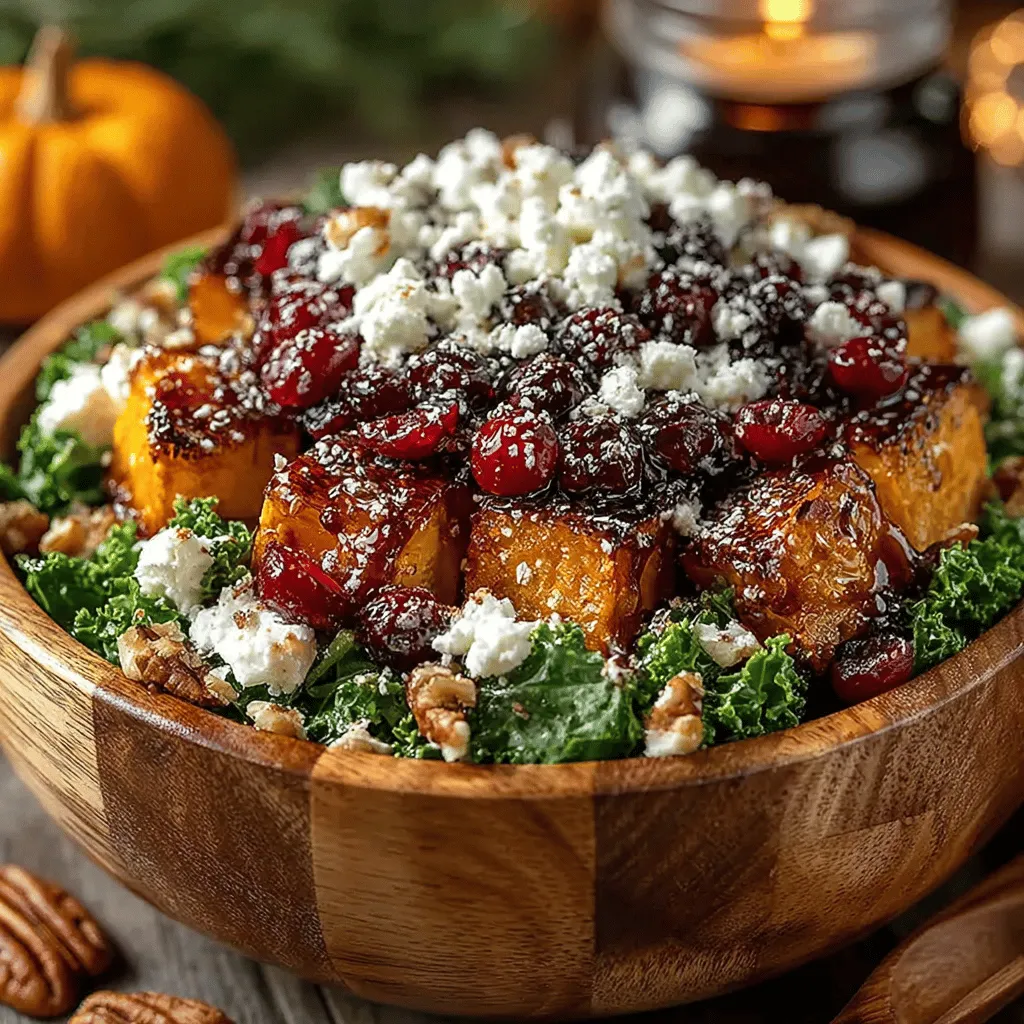Introduction
Welcome to the heart of autumn with our delightful Butternut Squash and Kale Salad. This recipe beautifully combines the earthy sweetness of roasted butternut squash with the robust flavor of kale, creating a vibrant and nutritious dish perfect for any autumn gathering. As the leaves turn golden and the air becomes crisp, this salad not only captures the essence of the season but also provides a hearty option for those seeking a healthy yet satisfying meal. Whether you’re looking for a light lunch, a side dish for dinner, or a centerpiece for your holiday table, this salad offers a symphony of flavors and textures that will please any palate.
The Health Benefits of Butternut Squash and Kale
Exploring the Nutritional Value
Both butternut squash and kale are packed with nutrients, making them an excellent choice for anyone aiming to boost their health through diet. Butternut squash is rich in vitamins A and C, which are essential for maintaining healthy skin and a robust immune system. One cup of cooked butternut squash provides over 200% of your daily recommended intake of vitamin A, primarily in the form of beta-carotene, a powerful antioxidant that helps combat free radicals in the body.
Kale, often hailed as a superfood, is loaded with vitamins K, A, and C, as well as minerals like calcium and potassium. It is also a great source of antioxidants, which are vital for reducing inflammation and protecting against chronic diseases. The high fiber content in kale aids in digestion and promotes a feeling of fullness, making it a fantastic addition to any salad.
When combined, these two powerhouse ingredients not only provide a plethora of vitamins and minerals but also create a satisfying meal that supports overall health.
The Importance of Seasonal Eating
Choosing seasonal ingredients like butternut squash and kale enhances not only the flavor and nutrition of your meals but also supports local farmers and reduces environmental impact. These vegetables thrive in cooler temperatures and are typically harvested in the fall, making them a staple in autumn cooking. Eating seasonally means you get to enjoy ingredients at their peak freshness, which translates to better taste and improved nutrient content.
Additionally, seasonal eating encourages a diverse diet and can lead to discovering new recipes and flavors that you may not have tried otherwise. By incorporating local produce into your meals, you also help sustain your community’s economy and reduce the carbon footprint associated with long-distance transportation of food.
Ingredients Breakdown
A Closer Look at the Key Ingredients
Let’s delve into the primary ingredients of the Butternut Squash and Kale Salad, highlighting their health benefits, flavor profiles, and why they complement each other so well.
1. Butternut Squash: The star of this dish, butternut squash adds a delightful sweetness and creamy texture when roasted. Beyond its taste, it is an excellent source of vitamins and dietary fiber. Roasting the squash caramelizes its natural sugars, enhancing its flavor and making it a perfect match for the slightly bitter kale.
2. Kale: This leafy green adds a robust texture and a slight earthiness to the salad. Its nutrient density makes it a popular choice in healthy recipes, and its ability to hold up well against hearty ingredients like roasted squash ensures that every bite remains satisfying.
3. Feta Cheese: While optional, crumbled feta cheese introduces a tangy flavor that beautifully contrasts with the sweetness of the squash. It adds creaminess and depth to the salad, making it more indulgent.
4. Pecans: Toasted pecans provide a lovely crunch and nutty flavor that complements the other ingredients. They also contribute healthy fats and additional protein, enhancing the salad’s nutritional profile.
5. Dressing: A simple vinaigrette made from olive oil, lemon juice, and maple syrup ties the salad together, adding brightness and a hint of sweetness that balances the flavors.
Optional Ingredients and Substitutions
This salad is versatile and can be customized based on personal preferences or dietary restrictions. For those who are vegan or dairy-free, consider omitting the feta cheese or substituting it with a plant-based alternative. Nutritional yeast can also be sprinkled on top for a cheesy flavor without the dairy.
If pecans are not available or if there are nut allergies, sunflower seeds or pumpkin seeds can provide a similar crunch and are a great source of healthy fats. Additionally, other seasonal vegetables, such as roasted Brussels sprouts or sweet potatoes, can be added to enhance the dish’s complexity and flavor.
Step-by-Step Instructions
Roasting the Butternut Squash
Roasting butternut squash is a simple yet rewarding process that brings out its natural sweetness and enhances its texture. Here’s how to do it perfectly:
1. Preparation: Start by preheating your oven to 400°F (200°C). While the oven heats, prepare the butternut squash. Cut off both ends of the squash, then carefully peel it using a vegetable peeler. Slice the squash in half lengthwise and remove the seeds with a spoon.
2. Cutting: After cleaning, chop the butternut squash into bite-sized cubes, aiming for uniform pieces to ensure even cooking.
3. Seasoning: Place the cubed squash onto a baking sheet lined with parchment paper. Drizzle with olive oil and sprinkle with salt, pepper, and any preferred spices (such as cinnamon or nutmeg for an autumnal twist). Toss to coat evenly.
4. Roasting: Spread the squash in a single layer to allow for proper caramelization. Roast in the preheated oven for about 25-30 minutes, or until the edges are golden brown and the squash is tender. Stir halfway through cooking to promote even browning.
5. Cooling: Once roasted, remove the baking sheet from the oven and let the squash cool slightly before adding it to the salad. The residual warmth will slightly wilt the kale, enhancing the overall texture of the dish.
Preparing the Kale
Kale can sometimes be tough and bitter, but with a little preparation, it becomes a delicious and nutritious base for your salad. Here’s how to prepare it:
1. Washing: Rinse the kale thoroughly under cold water to remove any dirt or grit.
2. Removing Stems: Hold the kale leaf by the stem and, using your other hand, pull the leafy part away from the stem. Discard the stems, which can be tough and fibrous.
3. Chopping: Once the leaves are removed, stack them and chop them into bite-sized pieces. This will make them easier to eat and help them absorb the dressing better.
4. Massaging: To reduce bitterness and improve tenderness, place the chopped kale in a large mixing bowl and drizzle a small amount of olive oil and a pinch of salt over it. Gently massage the kale with your hands for about 1-2 minutes until it becomes softer and slightly wilted.
With these foundational steps completed—roasting the butternut squash and preparing the kale—you are well on your way to creating a vibrant and satisfying Butternut Squash and Kale Salad. In the next part of this article, we will explore assembling the salad and crafting the perfect dressing to elevate its flavors even further. Stay tuned for a culinary journey that celebrates the best of autumn!

The Importance of Massaging Kale
Massaging kale is a crucial step in preparing this Butternut Squash and Kale Salad. This technique transforms the raw, fibrous leaves into tender, flavorful bites, enhancing both the taste and texture of your salad. When kale is massaged, the physical action breaks down its cell walls, allowing it to soften and become more palatable. This results in a less bitter flavor and a more pleasant mouthfeel, making it a delightful base for your autumn salad.
How to Massage Kale Properly
To massage kale effectively, start by removing the tough stems from the leaves. Tear the leaves into bite-sized pieces, then place them in a large mixing bowl. Drizzle a small amount of olive oil and a pinch of salt over the kale. Using your hands, gently rub and squeeze the leaves for about 2-3 minutes until they start to wilt and darken in color. This process not only enhances the kale’s flavor but also makes it easier for your body to digest. Properly massaged kale will have a softer texture and will better absorb the dressing, resulting in a more cohesive and enjoyable salad.
Crafting the Dressing
A well-crafted dressing can elevate your salad from ordinary to extraordinary. For the Butternut Squash and Kale Salad, we will create a dressing that balances acidity and sweetness, perfectly complementing the earthy flavors of the roasted butternut squash and the robust kale.
Ingredients for the Dressing
– 3 tablespoons olive oil
– 2 tablespoons apple cider vinegar
– 1 tablespoon maple syrup
– 1 teaspoon Dijon mustard
– Salt and pepper to taste
Balancing Acidity and Sweetness
To make the dressing, whisk together the olive oil, apple cider vinegar, maple syrup, and Dijon mustard in a small bowl. The apple cider vinegar provides a tangy acidity that cuts through the richness of the butternut squash, while the maple syrup adds a subtle sweetness that enhances the overall flavor profile. Adjust the seasoning with salt and pepper to taste, ensuring that the dressing is well-balanced. A great dressing should enhance the flavors of the salad without overpowering them, and this combination achieves just that.
Assembling the Salad
With the kale massaged and the dressing prepared, it’s time to assemble the salad. This step involves combining all the elements into a cohesive dish that’s as visually appealing as it is delicious.
Combining Ingredients
In a large mixing bowl, combine the massaged kale and roasted butternut squash. Then add any additional ingredients you wish to include, such as dried cranberries, nuts (like walnuts or pecans), or crumbled feta cheese for a creamy element. Pour the dressing over the salad and toss gently to ensure that all ingredients are evenly coated.
Presentation Tips
For an impressive presentation, consider layering the ingredients in a large, shallow bowl. Start with a base of kale, followed by the roasted squash, and then sprinkle the nuts, cheese, and cranberries on top. Garnish with fresh herbs, like parsley or chives, for a pop of color. Not only does this method make for a stunning display, but it also allows guests to see the vibrant colors of each ingredient, enticing them to dig in.
Flavor Enhancements and Variations
Adding Extra Ingredients for Depth
To further enhance the flavor profile and texture of your Butternut Squash and Kale Salad, consider incorporating additional ingredients. Slices of crisp apple or pear can introduce a refreshing sweetness that contrasts beautifully with the savory elements. Pomegranate seeds add a burst of color and a tartness that brightens the dish, while nuts can provide a satisfying crunch. Feel free to experiment with seasonal fruits or other vegetables to create your own unique variation.
Exploring Different Dressings
While the maple-Dijon dressing beautifully complements the salad, exploring different dressings can completely alter the flavor profile of this dish. For a Mediterranean twist, try a lemon-tahini dressing made with tahini, lemon juice, garlic, and water. Alternatively, a creamy avocado dressing can add richness and a different texture. The key is to match the dressing to the other flavors in your salad; the dressing should enhance, not overwhelm.
Serving Suggestions
Ideal Pairings for Your Salad
The Butternut Squash and Kale Salad is incredibly versatile, making it a perfect accompaniment to many main dishes. For a hearty meal, serve it alongside roasted chicken or grilled salmon, as the flavors complement each other beautifully. It also pairs well with vegetarian options like stuffed peppers or quinoa patties, providing a satisfying and nutritious meal.
Presentation Tips for a Stunning Display
Presentation plays a crucial role in making your salad an attractive addition to any table setting. Use a large, rustic wooden bowl or a glass salad dish to showcase the vibrant colors of the salad. Consider adding edible flowers or microgreens for a sophisticated touch. When serving, provide tongs or a large spoon for guests to easily help themselves, and always keep the dressing on the side if you are preparing the salad in advance. This prevents the kale from wilting and ensures that the salad remains fresh and crisp until served.
Conclusion
The Butternut Squash and Kale Salad is more than just a dish; it’s a celebration of autumn’s bounty and a testament to the beauty of seasonal cooking. With its colorful ingredients and harmonious flavors, this salad not only nourishes the body but also delights the senses. Whether you’re enjoying it on a crisp fall afternoon or serving it at a festive gathering, this recipe is sure to become a cherished staple in your culinary repertoire. Embrace the essence of autumn and savor every bite of this vibrant salad. The combination of textures and flavors will keep you coming back for more, making it a perfect choice for both everyday meals and special occasions.


